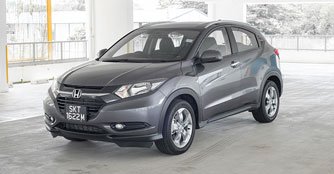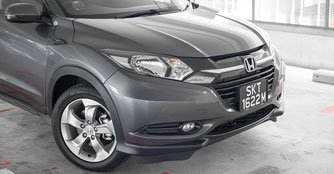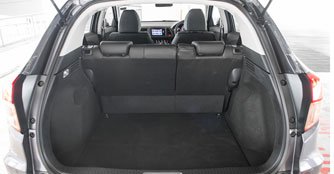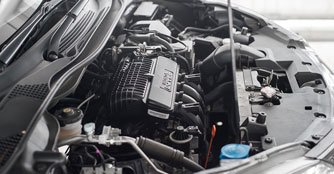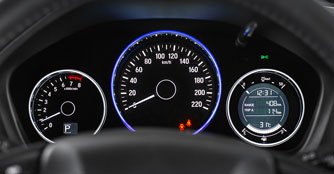Honda HR-V 1.5 LX Premium (A) Review
17 Aug 2015|48,937 views
With the success of the CR-V in the mid nineties, it is expected that Honda would again deliver something similar for the masses. Except this time, it comes in a smaller package. This brings our focus to this grey, second generation HR-V or Vezel as it is known in the Japanese market. Honda's latest compact Sports Utility Vehicle (SUV) based off the Jazz, and one of the hottest contenders in its segment.
These types of cars are rampant on our roads and for good reason. They offer space, comfort and decent fuel economy with the modern technologies available today. Unlike the first generation HR-V, whose moniker stood for Hi-rider Revolutionary Vehicle, Honda has now renamed it as the Hip Runabout Vehicle.
Exterior
Naming your vehicle 'hip' is a pretty big claim to stake. While the HR-V isn't MINI Countryman-style hip, it does look zestful. The quirky styling of the first generation HR-V has since been retired for a design that is more conventional and easier on the eyes. While some might say that the HR-V has gone mainstream, it definitely does so in good fashion.
Being a car that is targeted largely at young couples, the HR-V now adopts a groovy coupe-like frame with its curved window area and arching roof line. Cleverly complementing the sporty silhouette of the car are hidden rear door handles, an idea originating from the old Alfa Romeo 156 and more recently found also in cars like the Nissan Juke.
These types of cars are rampant on our roads and for good reason. They offer space, comfort and decent fuel economy with the modern technologies available today. Unlike the first generation HR-V, whose moniker stood for Hi-rider Revolutionary Vehicle, Honda has now renamed it as the Hip Runabout Vehicle.
Exterior
Naming your vehicle 'hip' is a pretty big claim to stake. While the HR-V isn't MINI Countryman-style hip, it does look zestful. The quirky styling of the first generation HR-V has since been retired for a design that is more conventional and easier on the eyes. While some might say that the HR-V has gone mainstream, it definitely does so in good fashion.
Being a car that is targeted largely at young couples, the HR-V now adopts a groovy coupe-like frame with its curved window area and arching roof line. Cleverly complementing the sporty silhouette of the car are hidden rear door handles, an idea originating from the old Alfa Romeo 156 and more recently found also in cars like the Nissan Juke.
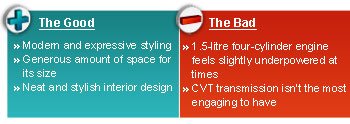 |
All form and no function has never been Honda's modus operandi and it shows on the HR-V. Despite bearing the visual appeal of a coupe, it still delivers the practicality of a compact SUV which is no wonder why we see these cars almost everywhere on our roads today.
At the higher end of the trim spectrum, the LX version offers a little more with 17-inch alloy wheels and LED indicators on the wing mirrors while the base model comes fitted with 16-inch wheels. The top of the range Premium model, which is the one we tested, comes with added roof rails that further adds on to the car's adventurous vibe. Fog lights come standard across all trims.
 |
Interior
The HR-V may well share the platform of the Jazz, but with a length of 4,294mm it's 159mm longer than a Nissan Juke. Do not be fooled by the car's sloping roofline, the cabin is actually larger on the inside than it appears to be on the outside, like the Perkin's tent in Harry Potter.
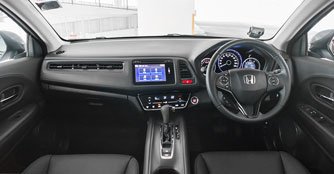
 The interior offers a simple yet upmarket look finished with refined piano black trims and soft touch materials
The interior offers a simple yet upmarket look finished with refined piano black trims and soft touch materials
Behind the wheel, the HR-V gives off a sporty semblance thanks to the high central console and stubby gear lever. On the Premium trim, a 7.0-inch Touchscreen Display Audio system (other trims get a 5.0-inch monitor) controls most of the entertainment system.
The HR-V may well share the platform of the Jazz, but with a length of 4,294mm it's 159mm longer than a Nissan Juke. Do not be fooled by the car's sloping roofline, the cabin is actually larger on the inside than it appears to be on the outside, like the Perkin's tent in Harry Potter.

Behind the wheel, the HR-V gives off a sporty semblance thanks to the high central console and stubby gear lever. On the Premium trim, a 7.0-inch Touchscreen Display Audio system (other trims get a 5.0-inch monitor) controls most of the entertainment system.
Functions like audio control, cruise control and Bluetooth hands-free telephone controls are located ergonomically on the steering wheel.
Boot capacity in the HR-V with the rear seats upright measures 470 litres, 40 litres more than the Nissan Qashqai and 1,533 litres with the rear seats down.
The ace in the hole for the HR-V is definitely its Jazz-derived Split Foldable 60:40 ULTRA rear seats. In layman terms, this means that the rear seat bases can be folded up against the seat backs, allowing tall items to be carried inside the car instead of getting ousted about if they were chucked in the boot.
Boot capacity in the HR-V with the rear seats upright measures 470 litres, 40 litres more than the Nissan Qashqai and 1,533 litres with the rear seats down.
The ace in the hole for the HR-V is definitely its Jazz-derived Split Foldable 60:40 ULTRA rear seats. In layman terms, this means that the rear seat bases can be folded up against the seat backs, allowing tall items to be carried inside the car instead of getting ousted about if they were chucked in the boot.
 |
The Drive
In Singapore, the HR-V is equipped with a four-cylinder in-line SOHC i-VTEC mated to an Earth Dreams CVT gearbox. If you are expecting a performance level that matches its looks, this is where the HR-V may disappoint.
Despite its coupe guise, it really is meant to be a fuel efficient, urban people mover. The engines offered in foreign models are 1.8-litre variants but unfortunately due to our COE burdens, a 1.5-litre unit had to be called upon in order for the HR-V to fall under the Category A segment.
Firmly planting your right foot down on the accelerator in an attempt to overtake might leave you at the receiving end of a flurry of engine noises as opposed to significant acceleration. Although the flappy paddle shifters offer the experience of a seven-speed automatic transmission, the primary objectives of delivering good fuel economy supercedes outright acceleration.
With that said, Honda makes up for the HR-V's lack of punch with a steering that is surprisingly direct. Combined with a firmer than expected suspension, you could find yourself having a little fun on twistier roads.
In Singapore, the HR-V is equipped with a four-cylinder in-line SOHC i-VTEC mated to an Earth Dreams CVT gearbox. If you are expecting a performance level that matches its looks, this is where the HR-V may disappoint.
Despite its coupe guise, it really is meant to be a fuel efficient, urban people mover. The engines offered in foreign models are 1.8-litre variants but unfortunately due to our COE burdens, a 1.5-litre unit had to be called upon in order for the HR-V to fall under the Category A segment.
Firmly planting your right foot down on the accelerator in an attempt to overtake might leave you at the receiving end of a flurry of engine noises as opposed to significant acceleration. Although the flappy paddle shifters offer the experience of a seven-speed automatic transmission, the primary objectives of delivering good fuel economy supercedes outright acceleration.
With that said, Honda makes up for the HR-V's lack of punch with a steering that is surprisingly direct. Combined with a firmer than expected suspension, you could find yourself having a little fun on twistier roads.
In our three days of HR-V ownership, we managed to clock an average fuel consumption of 15.2km/L, which is impressive for a naturally aspirated compact SUV. The ring around the HR-V's speedometer glows green when you go easy on the throttle and blushes blue when you put your foot down to indicate that you are door-handling the car like a maniac.
Conclusion
Honda is clearly ahead of the rat race for decently priced and reasonably sized urban cars and the HR-V further proves that point.
If you're looking for a car thats pleasantly designed, practical and economical with a cabin comfortable enough for five adults and some golf bags, look no further - the HR-V is your answer.
Conclusion
Honda is clearly ahead of the rat race for decently priced and reasonably sized urban cars and the HR-V further proves that point.
If you're looking for a car thats pleasantly designed, practical and economical with a cabin comfortable enough for five adults and some golf bags, look no further - the HR-V is your answer.
With the success of the CR-V in the mid nineties, it is expected that Honda would again deliver something similar for the masses. Except this time, it comes in a smaller package. This brings our focus to this grey, second generation HR-V or Vezel as it is known in the Japanese market. Honda's latest compact Sports Utility Vehicle (SUV) based off the Jazz, and one of the hottest contenders in its segment.
These types of cars are rampant on our roads and for good reason. They offer space, comfort and decent fuel economy with the modern technologies available today. Unlike the first generation HR-V, whose moniker stood for Hi-rider Revolutionary Vehicle, Honda has now renamed it as the Hip Runabout Vehicle.
Exterior
Naming your vehicle 'hip' is a pretty big claim to stake. While the HR-V isn't MINI Countryman-style hip, it does look zestful.
The quirky styling of the first generation HR-V has since been retired for a design that is more conventional and easier on the eyes. While some might say that the HR-V has gone mainstream, it definitely does so in good fashion.
Being a car that is targeted largely at young couples, the HR-V now adopts a groovy coupe-like frame with its curved window area and arching roof line. Cleverly complementing the sporty silhouette of the car are hidden rear door handles, an idea originating from the old Alfa Romeo 156 and more recently found also in cars like the Nissan Juke.
These types of cars are rampant on our roads and for good reason. They offer space, comfort and decent fuel economy with the modern technologies available today. Unlike the first generation HR-V, whose moniker stood for Hi-rider Revolutionary Vehicle, Honda has now renamed it as the Hip Runabout Vehicle.
Exterior
Naming your vehicle 'hip' is a pretty big claim to stake. While the HR-V isn't MINI Countryman-style hip, it does look zestful.
The quirky styling of the first generation HR-V has since been retired for a design that is more conventional and easier on the eyes. While some might say that the HR-V has gone mainstream, it definitely does so in good fashion.
Being a car that is targeted largely at young couples, the HR-V now adopts a groovy coupe-like frame with its curved window area and arching roof line. Cleverly complementing the sporty silhouette of the car are hidden rear door handles, an idea originating from the old Alfa Romeo 156 and more recently found also in cars like the Nissan Juke.
All form and no function has never been Honda's modus operandi and it shows on the HR-V. Despite bearing the visual appeal of a coupe, it still delivers the practicality of a compact SUV which is no wonder why we see these cars almost everywhere on our roads today.
At the higher end of the trim spectrum, the LX version offers a little more with 17-inch alloy wheels and LED indicators on the wing mirrors while the base model comes fitted with 16-inch wheels. The top of the range Premium model, which is the one we tested, comes with added roof rails that further adds on to the car's adventurous vibe. Fog lights come standard across all trims.
Interior
The HR-V may well share the platform of the Jazz, but with a length of 4,294mm it's 159mm longer than a Nissan Juke. Do not be fooled by the car's sloping roofline, the cabin is actually larger on the inside than it appears to be on the outside, like the Perkin's tent in Harry Potter.
Behind the wheel, the HR-V gives off a sporty semblance thanks to the high central console and stubby gear lever. On the Premium trim, a 7.0-inch Touchscreen Display Audio system (other trims get a 5.0-inch monitor) controls most of the entertainment system.
The HR-V may well share the platform of the Jazz, but with a length of 4,294mm it's 159mm longer than a Nissan Juke. Do not be fooled by the car's sloping roofline, the cabin is actually larger on the inside than it appears to be on the outside, like the Perkin's tent in Harry Potter.
Behind the wheel, the HR-V gives off a sporty semblance thanks to the high central console and stubby gear lever. On the Premium trim, a 7.0-inch Touchscreen Display Audio system (other trims get a 5.0-inch monitor) controls most of the entertainment system.
Functions like audio control, cruise control and Bluetooth hands-free telephone controls are located ergonomically on the steering wheel.
Boot capacity in the HR-V with the rear seats upright measures 470 litres, 40 litres more than the Nissan Qashqai and 1,533 litres with the rear seats down.
The ace in the hole for the HR-V is definitely its Jazz-derived Split Foldable 60:40 ULTRA rear seats. In layman terms, this means that the rear seat bases can be folded up against the seat backs, allowing tall items to be carried inside the car instead of getting ousted about if they were chucked in the boot.
Boot capacity in the HR-V with the rear seats upright measures 470 litres, 40 litres more than the Nissan Qashqai and 1,533 litres with the rear seats down.
The ace in the hole for the HR-V is definitely its Jazz-derived Split Foldable 60:40 ULTRA rear seats. In layman terms, this means that the rear seat bases can be folded up against the seat backs, allowing tall items to be carried inside the car instead of getting ousted about if they were chucked in the boot.
The
Drive
In Singapore, the HR-V is equipped with a four-cylinder in-line SOHC i-VTEC mated to an Earth Dreams CVT gearbox. If you are expecting a performance level that matches its looks, this is where the HR-V may disappoint.
Despite its coupe guise, it really is meant to be a fuel efficient, urban people mover. The engines offered in foreign models are 1.8-litre variants but unfortunately due to our COE burdens, a 1.5-litre unit had to be called upon in order for the HR-V to fall under the Category A segment.
Firmly planting your right foot down on the accelerator in an attempt to overtake might leave you at the receiving end of a flurry of engine noises as opposed to significant acceleration. Although the flappy paddle shifters offer the experience of a seven-speed automatic transmission, the primary objectives of delivering good fuel economy supercedes outright acceleration.With that said, Honda makes up for the HR-V's lack of punch with a steering that is surprisingly direct. Combined with a firmer than expected suspension, you could find yourself having a little fun on twistier roads.
In our three days of HR-V ownership, we managed to clock an average fuel consumption of 15.2km/L, which is impressive for a naturally aspirated compact SUV. The ring around the HR-V's speedometer glows green when you go easy on the throttle and blushes blue when you put your foot down to indicate that you are door-handling the car like a maniac.
Conclusion
Honda is clearly ahead of the rat race for decently priced and reasonably sized urban cars and the HR-V further proves that point.
If you're looking for a car thats pleasantly designed, practical and economical with a cabin comfortable enough for five adults and some golf bags, look no further - the HR-V is your answer.
Conclusion
Honda is clearly ahead of the rat race for decently priced and reasonably sized urban cars and the HR-V further proves that point.
If you're looking for a car thats pleasantly designed, practical and economical with a cabin comfortable enough for five adults and some golf bags, look no further - the HR-V is your answer.
Also read our comparison article on:
Honda HR-V 1.5 vs Skoda Karoq 1.5 vs Subaru XV 2.0i-SCar Information
Honda HR-V 1.5 LX Premium (A)
CAT A|Petrol|15.4km/L
Horsepower
88kW (118 bhp)
Torque
145 Nm
Acceleration
-
This model is no longer being sold by local distributor
All Used Honda HR-VThank You For Your Subscription.























